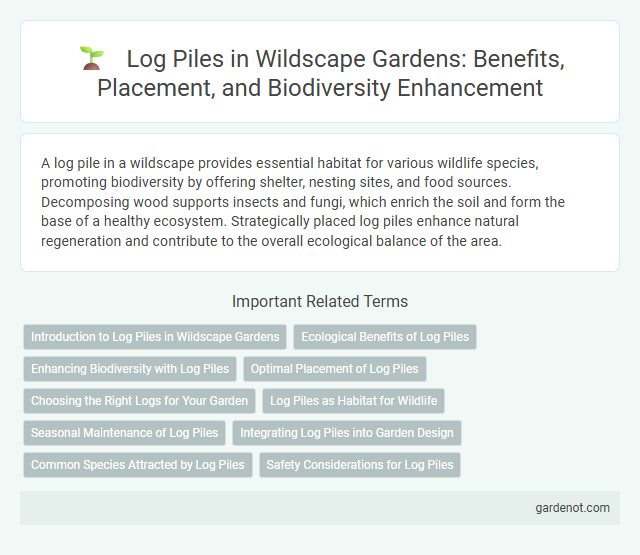A log pile in a wildscape provides essential habitat for various wildlife species, promoting biodiversity by offering shelter, nesting sites, and food sources. Decomposing wood supports insects and fungi, which enrich the soil and form the base of a healthy ecosystem. Strategically placed log piles enhance natural regeneration and contribute to the overall ecological balance of the area.
Introduction to Log Piles in Wildscape Gardens
Log piles in Wildscape Gardens provide essential habitats for insects, amphibians, and small mammals, contributing to biodiversity and ecosystem balance. These decaying wood structures promote decomposition processes, enriching soil nutrients and enhancing plant growth. Strategically placed log piles serve as shelter and breeding sites, supporting wildlife conservation efforts within the garden environment.
Ecological Benefits of Log Piles
Log piles create essential habitats for a variety of wildlife, including amphibians, insects, and small mammals, which rely on decaying wood for shelter and food. These structures promote biodiversity by supporting decomposers like fungi and bacteria that recycle nutrients back into the soil. Log piles also contribute to soil health and moisture retention, enhancing the overall ecosystem stability in Wildscape environments.
Enhancing Biodiversity with Log Piles
Log piles serve as vital habitats for various insects, amphibians, and small mammals, significantly boosting local biodiversity. They promote the decomposition process by providing a microhabitat for fungi and detritivores, enriching soil health and nutrient cycling. Incorporating log piles within wildscapes creates ecological niches that support wildlife diversity and ecosystem resilience.
Optimal Placement of Log Piles
Optimal placement of log piles in Wildscape enhances habitat complexity by providing essential shelter for insects, reptiles, and small mammals. Position log piles near woodland edges or within dense undergrowth to maximize biodiversity and support natural decomposition processes. Avoid overly exposed or waterlogged areas to ensure longevity and ecological function of the log pile.
Choosing the Right Logs for Your Garden
Selecting the right logs for your garden's wildscape enhances habitat quality and biodiversity. Opt for native hardwoods like oak, ash, and hawthorn, which provide essential nutrients and shelter for insects and small wildlife. Avoid treated or diseased wood to maintain a healthy ecosystem and support natural decomposition processes.
Log Piles as Habitat for Wildlife
Log piles create essential habitats by providing shelter and breeding sites for a variety of wildlife, including insects, amphibians, and small mammals. These decomposing wood structures support biodiversity by offering food sources such as fungi and invertebrates crucial for ecosystem health. Maintaining log piles in wildscapes enhances natural habitat complexity and promotes species conservation.
Seasonal Maintenance of Log Piles
Seasonal maintenance of log piles ensures habitat stability for wildlife by preventing decay and pest infestations. Regularly inspecting and repositioning logs in autumn and spring promotes optimal moisture levels and structural integrity. Clearing surrounding vegetation enhances airflow and sunlight exposure, supporting diverse ecosystems within the log pile.
Integrating Log Piles into Garden Design
Integrating log piles into garden design enhances biodiversity by providing essential habitats for insects, amphibians, and small mammals. Strategically placing log piles in shaded, moist areas supports decomposer fungi and improves soil health through natural nutrient cycling. Incorporating various sizes and types of wood optimizes ecological benefits while adding rustic aesthetic appeal to garden landscapes.
Common Species Attracted by Log Piles
Log piles attract a variety of common species such as hedgehogs, beetles, and amphibians like newts and frogs, providing essential shelter and breeding sites. Insects including woodlice, spiders, and centipedes thrive within decaying wood, supporting the broader food web by attracting birds and small mammals. These log piles create vital microhabitats that enhance biodiversity and promote ecological balance in wildscapes.
Safety Considerations for Log Piles
Log piles provide essential habitats for wildlife but require careful placement away from human activity areas to prevent accidents. Ensuring stability and avoiding stacking logs too high reduces the risk of collapsing, which can cause injury. Clear signage and regular inspections enhance safety while maintaining the ecological benefits of log piles in wildscapes.
Log pile Infographic

 gardenot.com
gardenot.com